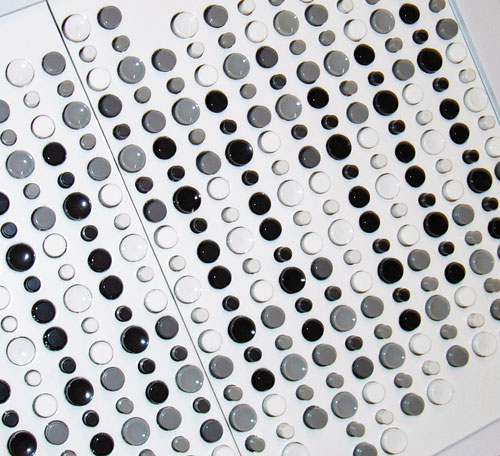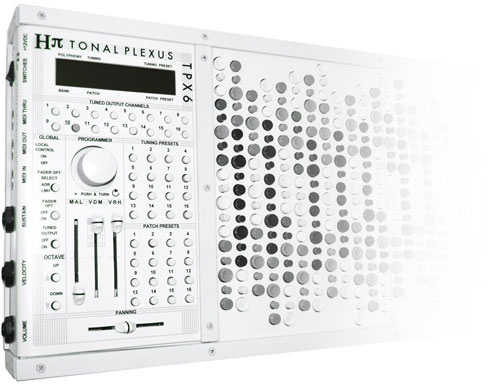



December 07, 2010

Composer Jesus Lopez recently contacted me from Australia with an interesting request: would it be possible for me to make a Tonal Plexus keyboard without colored keys - only black white and grey? And could the controls also be white? And the body, could that also be white?
A white Tonal Plexus. It would certainly be striking! Of course; yes, I said; I can do that. Since I make every keyboard by hand, I have no problems with these kinds of requests. And there was a good reason to make such a keyboard. You see, Jesus Lopez is color blind.
Most color blind people are known as dichromats, having what is called Red-Green blindness, the ablility to see colors well only in the yellow and blue parts of the spectrum. This is in fact the reason that the default color of the edge keys for Tonal Plexus keyboards was originally blue. Dr. Lopez has wide spectrum color blindness, which is much more rare. I supplied him with some keyboard images, which he used to experiment in Photoshop to find a layout which looked correct to him. The results are quite unique.

The keys themselves protrude through completely white top panels. There are no graphical boxes around key regions, nothing but the key caps themselves to delineate the structure.

The control panel has custom white knobs, with slider knobs of the 'grab' style, contrasting the standard 'push' style slider knobs used on standard TPX keyboards.

Dr. Lopez writes:
"I am going to use the Tonal Plexus to optimally generate microtonal themes and compositional functional blocks for my PhD thesis. Some info in my thesis is as follows: Preliminary ideas on discovering mental-state biased compositional paradigms for microtonal electro acoustic instruments: Introduction: The idea is to explore the mathematics /mental-state/music-perception continuum by using artificial intelligence (AI) techniques applied to music composition. This shall not be a scientific endeavor but rather the generation of a compositional framework that will guide my compositional outcomes during the last stages of my research time at the Conservatorium. Not only musical pieces will be composed, but also, specific electro-acoustic instruments will be designed for these. Therefore, this proposal pretends to be a project on electro-acoustic music composition. Finally, despite this proposal is based on a rigorous and highly systematic approach, the final outcomes will be exceedingly modulated by compositional creativity, previous compositional experience, my cultural background and ultimately my vision of the world. Artificial Intelligence for the generation of a compositional framework: AI or machine learning approaches can be either supervised or unsupervised. As I shall potentially apply them to composition, supervised methodologies attempt to generate compositional paradigms by learning from previous experiences sampled from human or previous compositions' input. Unsupervised techniques use well-known mathematics/biology inspired algorithms, which are universal, or live within their own realm, and attempt to loosely classify a compositional space of themes. Whether we considering supervised or unsupervised approaches, the target - or motivation - would be the listener mental state as induced by short musical passages (or themes). All themes would have to be as de-correlated as possible to western traditional musical forms to rule out trivial compositional/cultural biases, i.e. minor vs major triads, simple vs odd signatures, or traditional jazz forms. Ultimately, a large number of microtonal systems will be considered. Themes will also have to be parameterized in terms of their dynamics, timbers, tempo, and other second order mathematical measures of music, i.e. density of microtonal system, melodic range, counterpoint descriptives, and second order measures like the Laplacian on frequency time series, etc. Also, a rigorous notation system should be adopted to facilitate discussing themes from an aesthetic perspective and to allow interpreters to generate the themes in a way that is minimizes ambiguity. Nonetheless, such notation system should be open-ended to allow for modern interpretation but also with little dichotomies so it could be easily translated into natural language to be interpreted by the AI algorithms. I would preliminary use an adaptation of Schenker diagrams and perhaps lilypond package as a computational framework. Given, such archive of the themes (many issues to solve here - see challenges below), listeners will contribute their mental state by choosing from a set of images while listening to the music. This will annotate set of themes, hopefully, with, at least, pseudo-universal states of mind. If universality of theme and mental-states pairs is not achieved, this should not pose any constrain since the objective of this project is to generate a "guiding" compositional paradigm rather than proving that persons are universally biased in the same way by the same musical forms. After the themes are classified and an annotated archive is generated, a neural network (a supervised AI method) will be used to learn compositional paradigms that are meant to induce mental states - again hopefully with certain level of universality. These neural networks could also be potentially used to augment the themes-set by generating new themes in a generative basis. Concomitantly, Knohonen maps (an unsupervised AI approach) will be generated to discover clusters of compositional parameters - clues - that might also correlate with mental sates and subsequently enrich my compositional framework. If all goes well [nervousness pause] we should end up with an intelligent artificial framework that will allow composers to guide their creative process based on (1) themes annotate by metal states they induce; (2) Neural networks that will generate themes that will potentially generate predetermined mental sates; (3) Kohonen clusters of compositional and improvisational clues that should either induce mental state sequences in the listener or perhaps augment/inform the performance experience of a given his/her current mental-state. With this intelligent framework at certain level of maturity, I intend to achieve the following objectives: (1) Generate a series of compositions based on predetermined mental state sequences. Ideally, the compositions will include a great deal of improvisation guidelines also based on the discovered compositional paradigms that shall be adopted by the interpreter/improviser at he/she leisure as informed by they current mental state. (2) Since the paradigms departed from highly open-ended themes (i.e., micro tonality, and variations of the real-time variations electronics) instruments will be specially designed and constructed for these pieces. These instruments will be based on traditional musical instruments with altered tunings, spatial arrangements, and electro-acoustic modifications. Some challenges to this PhD are: 1. Adopting a usable notation system - preliminary I am thinking on 2. Generating a large enough sample of themes and recruiting candidates. 3. Not finding themes that are universally correlated to mental states. 4. Eliminating cultural music form biases. 5. Cost and time associated with constructing/modifying specialized instruments. 6. Finding sound ways for parametrizing themes in a mathematical that it is still translatable to music notation or improvisation guidelines for interpreters.
So there you have it! The white "Moby Plexus" will be put to good use in some rather interesting research.
It's a great pleasure for me to come into contact with so many interesting personalities in the music world through my business. In future blog posts, I will be featuring other musicians and their stories. Stay tuned!
[ Showing 1 entry | Previous entry | Next entry | Show all entries ]